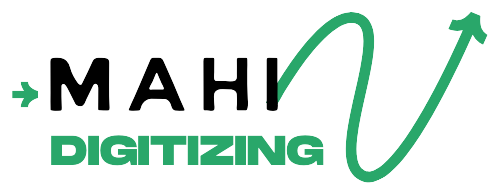Understanding the core differences between pixel and vector logos is essential for anyone involved in branding or design. At Mahi Digitizing, we help businesses choose and digitize the right logo format for every application—whether it’s for print, embroidery, or digital use.
What is a Pixel Logo?
A pixel logo, also called a raster logo, is made up of tiny squares called pixels. These logos are resolution-dependent, meaning they lose quality when scaled beyond their original size.
Common formats for pixel logos include JPEG, PNG, GIF, and BMP. These formats are widely used for web images and digital mockups due to their accessibility.
However, pixel logos are not ideal for resizing, especially for print or embroidery, as they can become blurry or pixelated when enlarged.
They are best suited for static display where the size remains fixed, such as social media icons or website headers.
Editing pixel-based logos can also be challenging, especially when trying to isolate parts of the image for modification.
If you only have a raster logo and need it digitized for embroidery, our vectorization service is the ideal solution.
What is a Vector Logo?
A vector logo is composed of paths, lines, and curves defined by mathematical equations, not pixels. This makes them infinitely scalable without any loss in quality.
Common formats for vector logos include AI, SVG, EPS, and PDF. These are industry standards for professional branding, signage, and embroidery digitizing.
Vector logos are ideal for resizing, printing at any dimension, and ensuring crisp edges in all formats—whether it’s a business card or a billboard.
They are easily editable, allowing designers to change colors, shapes, and elements with precision and flexibility.
Because of their scalability and clarity, vector logos are the preferred format for embroidery, screen printing, and product branding.
We recommend submitting a vector logo when requesting a free digitizing quote for embroidery or custom patches.
Why Logo Format Matters for Digitizing
When digitizing a logo for embroidery or printing, the format plays a critical role in determining the outcome’s quality and precision.
Pixel logos require manual cleanup or conversion to vectors before they can be accurately digitized for stitch paths.
Vector logos, by contrast, allow for cleaner outlines and consistent results, reducing the chance of distortion or detail loss.
If you send a pixel logo for digitizing, we often have to recreate it in vector form to achieve the best embroidery output.
Choosing the correct format early saves time, avoids added costs, and ensures your logo is reproduced accurately on apparel and merchandise.
At Mahi Digitizing, we assess your logo and help you make the right choice for your production needs.
When to Use Each Logo Type
- Use pixel logos for online content, email signatures, and web banners.
- Use vector logos for printing, embroidery, signage, and physical branding.
- Pixel logos are suitable for photographs and detailed graphics not meant for scaling.
- Vector logos are perfect for crisp, professional brand presentation at any size.
- If you’re unsure, send both versions to your designer or digitizer for evaluation.
- We can convert pixel logos to vector for better print and stitch results—just contact us.
Need Help Choosing the Right Logo Format?
Whether you’re creating a new logo or updating an old one, choosing the right format can make all the difference. Vector graphics are the standard for embroidery and branding, but we also work with pixel logos by vectorizing them first.
At Mahi Digitizing, our expert team provides both JPG to vector conversion and professional embroidery digitizing to suit your branding needs.
We’ll help you get the most professional results, no matter where or how your logo will be used—from patches to print to promo wear.
Need a fast quote? Request a free quote here and send us your logo files—we’ll guide you step-by-step.
Still have questions? Visit our Contact Us page or explore our full list of services.
